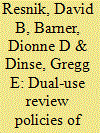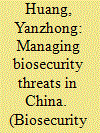|
|
|
Sort Order |
|
|
|
Items / Page
|
|
|
|
|
|
|
| Srl | Item |
| 1 |
ID:
103478


|
|
|
|
|
| Publication |
2011.
|
| Summary/Abstract |
The events and aftermath of September 11, 2001, accelerated a search for personnel reliability test measures to identify individuals who could pose a threat to our nation's security and safety. The creation and administration of a behavioral health screen for BSL-4 laboratory workers at the National Institutes of Health represents a pioneering effort to proactively build a BSL-4 safety culture promoting worker cohesiveness, trust, respect, and reliability with a balance of worker privacy and public safety.
|
|
|
|
|
|
|
|
|
|
|
|
|
|
|
|
| 2 |
ID:
103485


|
|
|
|
|
| Publication |
2011.
|
| Summary/Abstract |
To address biosecurity issues, government agencies, academic institutions, and professional societies have developed policies concerning the publication of "dual-use" biomedical research-that is, research that could be readily applied to cause significant harm to the public, the environment, or national security. We conducted an e-mail survey of life science journals to determine the percentage that have a dual-use policy. Of the 155 journals that responded to our survey (response rate 39%), only 7.7% stated that they had a written dual-use policy and only 5.8% said they had experience reviewing dual-use research in the past 5 years. Among the potential predictors we investigated, the one most highly associated with a journal having a written dual-use policy was membership in the Nature Publishing Group (positive association). When considered individually, both previous experience with reviewing dual-use research and the journal's impact factor appeared to be positively associated with having a written dual-use policy, but only the former remained significant after adjusting for publishing group. Although preventing the misuse of scientific research for terrorist or criminal purposes is an important concern, few biomedical journals have dual-use review policies. Journals that are likely to review research that raises potential dual-use concerns should consider developing dual-use policies.
|
|
|
|
|
|
|
|
|
|
|
|
|
|
|
|
| 3 |
ID:
103483


|
|
|
|
|
| Publication |
2011.
|
| Summary/Abstract |
All-hazards exercises bring together emergency response partners at the local, regional, state, and federal levels for the primary purposes of testing response plans, defining roles and responsibilities, assessing capabilities, and making necessary improvements prior to an actual incident. To better understand the benefits and challenges of conducting regional (ie, multicounty) exercises, a study was carried out by the North Carolina Preparedness and Emergency Response Research Center at the University of North Carolina Gillings School of Global Public Health. This article describes 5 all-hazards regional exercises conducted by Public Health Regional Surveillance Teams (PHRSTs) in North Carolina in 2009 and highlights 4 unique benefits that resulted from the exercises beyond meeting explicit objectives to test plans and identify areas for improvement: (1) building relationships among response partners, (2) promoting public health assets, (3) testing multiple communications systems, and (4) training exercise evaluators. Challenges of planning and conducting regional exercises also are addressed, followed by recommendations for maximizing the effectiveness of regional public health exercises.
|
|
|
|
|
|
|
|
|
|
|
|
|
|
|
|
| 4 |
ID:
103480


|
|
|
|
|
| Publication |
2011.
|
| Summary/Abstract |
Compared to the extensive literature on bioterrorism and biosecurity in the United States, less analysis has been conducted on similar challenges in China. This article seeks to fill this void by providing an integrated and updated assessment of 3 major biosecurity threats China faces: biowarfare, bioterrorism, and biocrimes. An analysis of China's biosecurity threats and biodefense building suggest varying levels of risk associated with each threat type. First, a direct bioweapons attack on China is highly unlikely, although the threat of biowarfare cannot be simply written off. Second, potential perpetrators of bioterrorism have capabilities at their disposal for carrying out such attacks. While terrorist organizations in China do not have a strong interest in bioterrorism, the limited state capability to counter such a threat may increase the risk in the future. Third, unlike the threats of biowarfare and bioterrorism, potential perpetrators of biocrimes have both incentives and capabilities, and biocrimes can produce reactions far out of proportion to the actual number of casualties. Despite the distinct biosecurity challenges it faces, China has yet to articulate a differentiated and coherent strategy to effectively tackle the challenges. Assessing different types of biosecurity threats in terms of degrees of risk not only provides greater analytical clarity but also has important implications for the strategies required to manage the risks.
|
|
|
|
|
|
|
|
|
|
|
|
|
|
|
|
| 5 |
ID:
103475


|
|
|
|
|
| Publication |
2011.
|
| Summary/Abstract |
In fall 2009, the New York City Department of Health and Mental Hygiene (DOHMH) operated 58 points of dispensing (PODs) over 5 weekends to provide influenza A (H1N1) 2009 monovalent vaccination to New Yorkers. Up to 7 sites were opened each day across the 5 boroughs, with almost 50,000 New Yorkers being vaccinated. The policies and protocols used were based on those developed for New York City's POD Plan, the cornerstone of the city's mass prophylaxis planning. Before the H1N1 experience, NYC had not opened more than 5 PODs simultaneously and had only experienced the higher patient volume seen with the H1N1 PODs on 1 prior occasion. Therefore, DOHMH identified factors that contributed to the success of POD operations, as well as areas for improvement to inform future mass prophylaxis planning and response. Though this was a relatively small-scale, preplanned operation, during which a maximum of 7 PODs were operated on a given day, the findings have implications for larger-scale mass prophylaxis planning for emergencies.
|
|
|
|
|
|
|
|
|
|
|
|
|
|
|
|
|
|
|
|
|